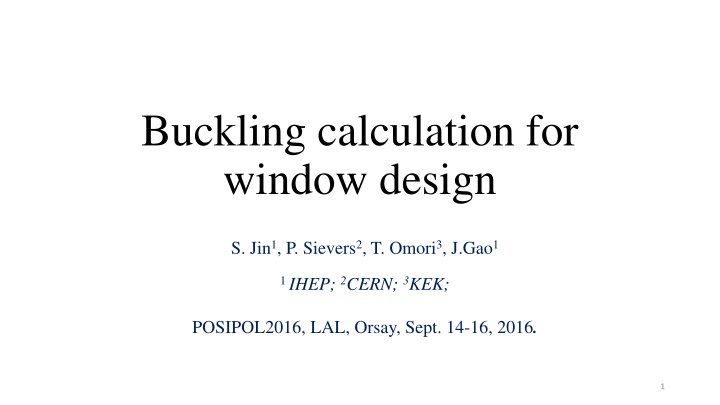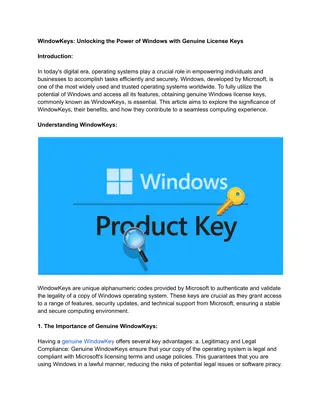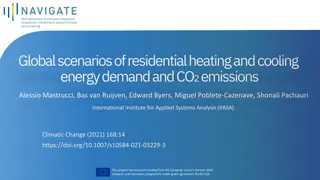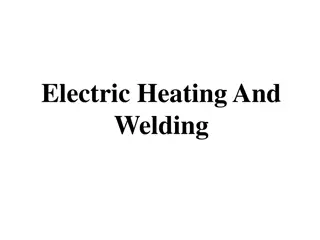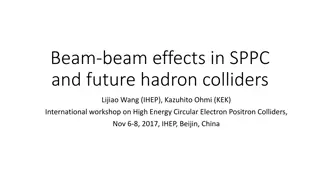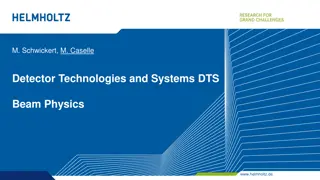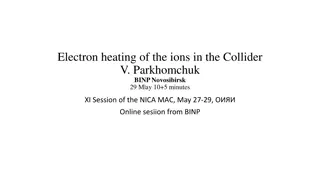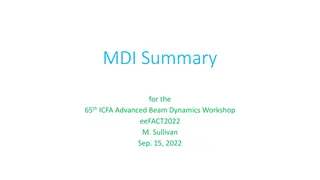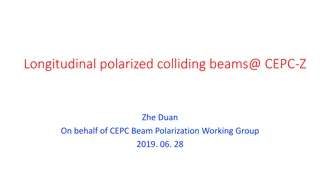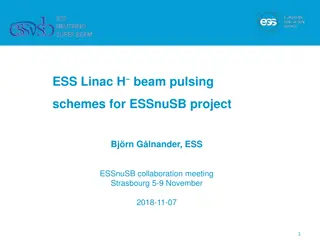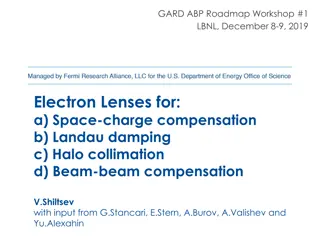Buckling Analysis for Thin Windows in Beam Heating Studies
Studies on thin Ti-windows are vital for target containment and vacuum windows. This analysis focuses on buckling response of thin windows to beam heating using Gaussian temperature profiles. By examining critical peak temperatures and stress-displacement relationships, insights into buckling behavior for 0.1mm and 0.2mm thickness windows are presented. The results show when buckling may occur under different conditions, providing valuable information for window design in beam applications.
Download Presentation

Please find below an Image/Link to download the presentation.
The content on the website is provided AS IS for your information and personal use only. It may not be sold, licensed, or shared on other websites without obtaining consent from the author.If you encounter any issues during the download, it is possible that the publisher has removed the file from their server.
You are allowed to download the files provided on this website for personal or commercial use, subject to the condition that they are used lawfully. All files are the property of their respective owners.
The content on the website is provided AS IS for your information and personal use only. It may not be sold, licensed, or shared on other websites without obtaining consent from the author.
E N D
Presentation Transcript
Buckling calculation for window design S. Jin1, P. Sievers2, T. Omori3, J.Gao1 1 IHEP; 2CERN; 3KEK; POSIPOL2016, LAL, Orsay, Sept. 14-16, 2016. 1
Introduction Studies on thin Ti-windows are important for the containment of targets and vacuum windows. In the following a first approach is made, studying the response of thin windows to beam heating by buckling. 2
The temperature profile used before was uniform. Now, the Gauss temperature profiles are used. ? ?,? = C ? ?2 32 Sigma=4mm. Thickness of 0.1mm and 0.2mm of the windows are calculated, respectively. Following temperature is checked: 23.5 C and 47 C for 0.1mm window 47 C and 94 C for 0.2mm window These values resulted from a study, made by A. Ushakov for the window of the photon beam dump, where however the rms value was smaller, about 1.0 mm. In the first part we continue, however, with a rms of 4 mm, which gives pessimistic results, as compared to smaller beams with the same peak temperature. For better understanding, we compare cases with buckling and cases, where buckling is not allowed. 3
1. Buckling analysis for 0.1mm thickness window with Gauss profile temperature 1stmode Critical Peak Temperature (C) Mode 1 24.95 2 47.02 2nd mode 3 47.03 4 82.73 5 82.90 3rdmode It shows that for 0.1mm thickness window, it will start to buckle with Gauss temperature profiles at peaks temperature of about 25C and 47C. The schematic of modes shape are shown as above. 4
v. M. stresses and displacement for 1stand 2ndorder of buckling for 0.1mm window 120 0.2 displacement for 1st order (mm) v.M.stress (MPa) for 1st order v.M.stress (MPa) for 2nd order 0.18 100 displacement for 2nd order (mm) 0.16 maximum displacement (mm) maximum v. M.stress (MPa) 0.14 80 0.12 0.1 60 0.08 40 0.06 0.04 20 0.02 0 0 0 20 40 60 80 0 20 40 60 80 temperature (C) temperature (C) v. M. stress for 1storder and 2ndorder mode Displacement for 1storder and 2ndorder mode We can see that the 1storder buckling will take place earlier than 2ndorder buckling mode. The displacement for the 1st order buckling is larger than for the 2nd order and the stresses are not very different for 1. and 2. order, just the shapes are different. 5
2. Buckling analysis for 0.2mm thickness window with Gauss profile temperature (1) Critical Peak Temperature (C) Mode 1 99.603 2 187.56 3 187.6 4 329.64 5 330.37 It shows that for 0.2mm thickness window, there will not be buckling under the Gauss temperature profile if the peak temperature is below of 99.6C 6
0.2mm thickness window with Gauss profile temperature (2) 2.50E-01 3.00E+02 displacement(mm) v.M.stress (MPa) 2.50E+02 2.00E-01 maximum v. M.stress (MPa) maximum displacement (mm) 2.00E+02 1.50E-01 1.50E+02 1.00E-01 1.00E+02 5.00E-02 5.00E+01 0.00E+00 0.00E+00 0 50 Peak temperature (C) 100 150 We calculated the displacement and v.M. stress in the center versus temperature. Buckling starts at around 94C and the stress rises sharply from 100 MPa at 110C to 210 MPa at 130C. P
3. Buckling and non-buckling results comparison 140 300 v.M.stress without buckling (MPa) v.M.stress without buckling (MPa) 120 250 maximum v. M. Stress (MPa) v.M.stress with buckling (MPa) maximum v. M. Stress (MPa) v.M.stress with buckling (MPa) 100 200 80 150 60 100 40 50 20 0 0 0 50 temperature (C) 100 150 0 50 temperature (C) 100 150 v. M. stress comparison of buckling and non- buckling results for 0.2mm window v. M. stress comparison of buckling and non- buckling results for 0.1mm window 8
4. Gauss profile temperature with rms of 1mm. The peak temperatures are 23.5 oC and 47. for 0.1 and 0.2 mm thickness when rms=4mm. Considering now a smaller beam with rms = 1mm ? ?,? = C ? ?2 2 9
Critical Peak Temperature of buckling with a rms beam of 1.0mm Critical Peak Temperature (C) Critical Peak Temperature (C) Mode Mode 1 196 1 785 2 469 2 1870 3 469 3 1870 4 531 4 2107 5 884 5 3495 0.1mm thickness window. It will buckle at about 196C. 0.2 mm thickness window. There will be no buckling under 720C. So, we just consider 1stmode for both of 0.1 mm and 0.2 mm window for one beam. 10
For 0.1 mm thickness window and a rms beam of 1.0 mm 1.60E-01 3.50E+02 displacement(mm) v.M.stress (MPa) 1.40E-01 3.00E+02 maximum v. M.stress (MPa) 1.20E-01 2.50E+02 maximum displacement (mm) 1.00E-01 2.00E+02 8.00E-02 1.50E+02 6.00E-02 1.00E+02 4.00E-02 5.00E+01 2.00E-02 0.00E+00 0.00E+00 0 100 200 300 temperature (C) 11
For 0.2 mm thickness window and a rms beam of 1.0 mm 0.3 1000 displacement(mm) v.M.stress (MPa) 900 0.25 800 maximum v. M.stress (MPa) maximum displacement (mm) 700 0.2 600 0.15 500 400 0.1 300 200 0.05 100 0 0 720 C 0 200 400 600 temperature (C) 800 1000 1200 1400 At the peak temperature of 720 C, the max. v. M. stress is about 373MPa. 12
Summary Simulation with different beam sizes, window thicknesses are done. Results on displacements, stresses and temperatures where buckling starts and also displacements and stresses at the expected and assumed temperatures are obtained. Following is a table to detailed results. Critical Peak Temperature (C) Max. v. M. Stress at excepted peak temperatures (MPa) thicknessBuckling Max.v. M. Stress in buckling (MPa) Excepted peak temperatures ( C ) Mode 23.5 47 23.5 47 47 94 23.5 47 47 94 21 75 21 63 37 78 11.7 23.5 23.5 47 1st 25 27 at 25C to 56 at 34C 0.1mm rms=4 2nd/3rd 47 34 at 33C to 78 at 55C 0.2mm 1st 99.6 85 at 99C to 212 at 129C 0.1mm 1st 196 108 at 196C to 176 at 240C rms=1 0.2mm 1st 785 435 at 785C to 881 at 1076C 13
